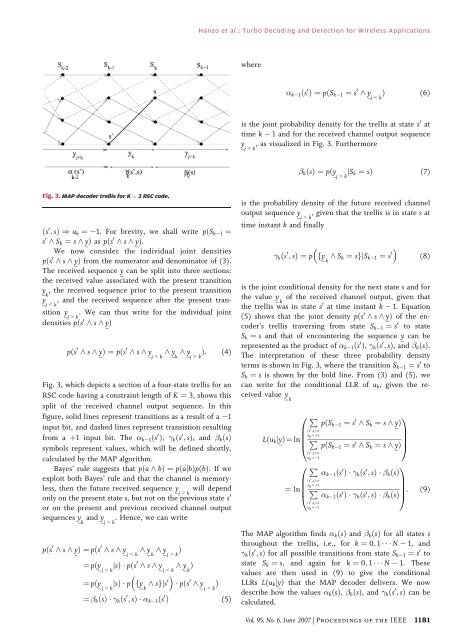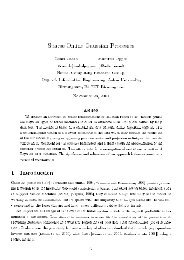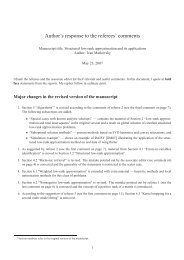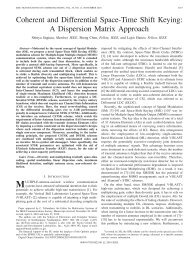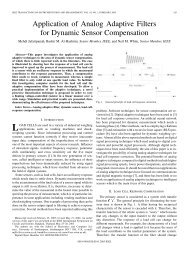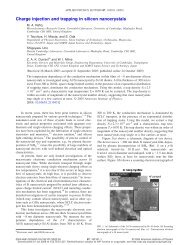Turbo Decoding and Detection for Wireless Applications
Turbo Decoding and Detection for Wireless Applications
Turbo Decoding and Detection for Wireless Applications
Create successful ePaper yourself
Turn your PDF publications into a flip-book with our unique Google optimized e-Paper software.
Fig. 3. MAP decoder trellis <strong>for</strong> K ¼ 3RSCcode.<br />
ðs0 ; sÞ )uk ¼ 1. For brevity, we shall write pðSk 1 ¼<br />
s0 ^ Sk ¼ s ^ yÞ as pðs0 ^ s ^ yÞ.<br />
We now consider the individual joint densities<br />
pðs0 ^ s ^ yÞ from the numerator <strong>and</strong> denominator of (3).<br />
The received sequence y can be split into three sections:<br />
the received value associated with the present transition<br />
y , the received sequence prior to the present transition<br />
k<br />
y , <strong>and</strong> the received sequence after the present tran-<br />
j G k<br />
sition y . We can thus write <strong>for</strong> the individual joint<br />
j 9 k<br />
densities pðs0 ^ s ^ yÞ<br />
pðs 0 ^ s ^ yÞ ¼pðs 0 ^ s ^ y j G k ^ y k ^ y j 9 k Þ: (4)<br />
Fig. 3, which depicts a section of a four-state trellis <strong>for</strong> an<br />
RSC code having a constraint-length of K ¼ 3, shows this<br />
split of the received channel output sequence. In this<br />
figure, solid lines represent transitions as a result of a 1<br />
input bit, <strong>and</strong> dashed lines represent transistion resulting<br />
from a þ1 input bit. The k 1ðs 0 Þ, kðs 0 ; sÞ, <strong>and</strong> kðsÞ<br />
symbols represent values, which will be defined shortly,<br />
calculated by the MAP algorithm.<br />
Bayes’ rule suggests that pða ^ bÞ ¼pðajbÞpðbÞ. Ifwe<br />
exploit both Bayes’ rule <strong>and</strong> that the channel is memoryless,<br />
then the future received sequence y j 9 k will depend<br />
only on the present state s, butnotonthepreviousstates 0<br />
or on the present <strong>and</strong> previous received channel output<br />
sequences y k <strong>and</strong> y j G k . Hence, we can write<br />
pðs 0 ^ s ^ yÞ ¼pðs 0 ^ s ^ y j G k ^ y k ^ y j 9 k Þ<br />
¼ pðy j 9 k jsÞ pðs 0 ^ s ^ y j G k ^ y k Þ<br />
¼ pðy j 9 k jsÞ p fy k ^ sgjs 0<br />
pðs 0 ^ y j G k Þ<br />
¼ kðsÞ kðs 0 ; sÞ k 1ðs 0 Þ (5)<br />
Hanzo et al.: <strong>Turbo</strong> <strong>Decoding</strong> <strong>and</strong> <strong>Detection</strong> <strong>for</strong> <strong>Wireless</strong> <strong>Applications</strong><br />
where<br />
k 1ðs 0 Þ¼pðSk 1 ¼ s 0 ^ y j G k Þ (6)<br />
is the joint probability density <strong>for</strong> the trellis at state s 0 at<br />
time k 1 <strong>and</strong> <strong>for</strong> the received channel output sequence<br />
y j G k ,asvisualizedinFig.3.Furthermore<br />
kðsÞ ¼pðy j 9 k jSk ¼ sÞ (7)<br />
is the probability density of the future received channel<br />
output sequence y j 9 k , given that the trellis is in state s at<br />
time instant k <strong>and</strong> finally<br />
kðs 0 ; sÞ ¼p fy k ^ Sk ¼ sgjSk 1 ¼ s 0<br />
(8)<br />
is the joint conditional density <strong>for</strong> the next state s <strong>and</strong> <strong>for</strong><br />
the value y k of the received channel output, given that<br />
the trellis was in state s 0 at time instant k 1. Equation<br />
(5) shows that the joint density pðs 0 ^ s ^ yÞ of the encoder’s<br />
trellis traversing from state Sk 1 ¼ s 0 to state<br />
Sk ¼ s <strong>and</strong> that of encountering the sequence y can be<br />
represented as the product of k 1ðs 0 Þ, kðs 0 ; sÞ, <strong>and</strong> kðsÞ.<br />
The interpretation of these three probability density<br />
terms is shown in Fig. 3, where the transition Sk 1 ¼ s 0 to<br />
Sk ¼ s is shown by the bold line. From (3) <strong>and</strong> (5), we<br />
can write <strong>for</strong> the conditional LLR of uk, given the received<br />
value y k<br />
P<br />
ðs<br />
LðukjyÞ¼ln<br />
0 pðSk 1 ¼ s<br />
;sÞ)<br />
uk¼þ1 0 ^ Sk ¼ s ^ yÞ<br />
P<br />
pðSk 1 ¼ s0 0<br />
1<br />
B<br />
C<br />
B<br />
C<br />
B<br />
C<br />
@<br />
^ Sk ¼ s ^ yÞA<br />
ðs 0 ;sÞ)<br />
u k ¼ 1<br />
0 P<br />
B<br />
¼ lnB<br />
P<br />
@<br />
ðs0 ;sÞ)<br />
uk¼þ1 ðs 0 ;sÞ)<br />
u k ¼ 1<br />
k 1ðs0Þ kðs0 ; sÞ kðsÞ<br />
k 1ðs0Þ kðs0 1<br />
C<br />
C:<br />
(9)<br />
; sÞ kðsÞA<br />
The MAP algorithm finds kðsÞ <strong>and</strong> kðsÞ <strong>for</strong> all states s<br />
throughout the trellis, i.e., <strong>for</strong> k ¼ 0; 1 N 1, <strong>and</strong><br />
kðs 0 ; sÞ <strong>for</strong> all possible transitions from state Sk 1 ¼ s 0 to<br />
state Sk ¼ s, <strong>and</strong> again <strong>for</strong> k ¼ 0; 1 N 1. These<br />
values are then used in (9) to give the conditional<br />
LLRs LðukjyÞ that the MAP decoder delivers. We now<br />
describe how the values kðsÞ, kðsÞ, <strong>and</strong> kðs 0 ; sÞ can be<br />
calculated.<br />
Vol. 95, No. 6, June 2007 | Proceedings of the IEEE 1181


